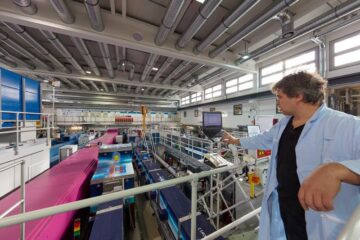Jaw Positioning Device – Precise midface-related maxilla repositioning during orthognathic surgery

Occlusion irregularities can surgically be treated by corrective osteotomies of mandible and / or maxilla. However, exact midface-related repositioning of the maxilla after LeFort I Osteotomy remains challenging, as the mobilised parts of the jaw are free to move three-dimensionally. Previous approaches are all afflicted with considerable inaccuracy and some of them are associated with additional radiation exposure caused by three-dimensional imaging.
This invention allows exact midface-related maxilla repositioning during mono- or bimaxillary surgery. The jaw positioning device comprises three splints (primary-, secondary- and reference splint) and three connection bars. The maxillary shift is planned preoperatively by model-surgery and encoded by the difference between primary- and secondary splint. There is no need for navigational systems or complex bone models based on three-dimensional imaging. During surgery, the primary splint, which fits exactly to the occlusional surfaces of the maxillary teeth, is placed on the dental arch. The primary splint’s outer face features a definded surface profile, on which the reference splint is placed. In the next step, connection bars to three intraorally accessible points of the patient’s bony midface are fixed on the reference splint. In this way, the reference splint can be replaced exactly in a well-defined midface-related position, also without the primary splint. After LeFort I osteotomy, the maxilla can be precisely positioned at the target position by use of the secondary splint, that also fits exactly to the corresponding surface of the reference splint.
Weitere Informationen: PDF
PROvendis GmbH
Tel.: +49 (0)208/94105 10
Ansprechpartner
Dipl.-Ing. Alfred Schillert
Media Contact
Alle Nachrichten aus der Kategorie: Technologieangebote
Neueste Beiträge

Bakterien für klimaneutrale Chemikalien der Zukunft
Forschende an der ETH Zürich haben Bakterien im Labor so herangezüchtet, dass sie Methanol effizient verwerten können. Jetzt lässt sich der Stoffwechsel dieser Bakterien anzapfen, um wertvolle Produkte herzustellen, die…

Batterien: Heute die Materialien von morgen modellieren
Welche Faktoren bestimmen, wie schnell sich eine Batterie laden lässt? Dieser und weiteren Fragen gehen Forschende am Karlsruher Institut für Technologie (KIT) mit computergestützten Simulationen nach. Mikrostrukturmodelle tragen dazu bei,…

Porosität von Sedimentgestein mit Neutronen untersucht
Forschung am FRM II zu geologischen Lagerstätten. Dauerhafte unterirdische Lagerung von CO2 Poren so klein wie Bakterien Porenmessung mit Neutronen auf den Nanometer genau Ob Sedimentgesteine fossile Kohlenwasserstoffe speichern können…

















